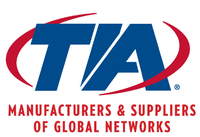Telecommunications Industry Association

The Telecommunications Industry Association (TIA) is accredited by the American National Standards Institute (ANSI) to develop voluntary, consensus-based industry standards for a wide variety of Information and Communication Technologies (ICT) products, and currently represents nearly 400 companies. TIA's Standards and Technology Department operates twelve engineering committees, which develop guidelines for private radio equipment, cellular towers, data terminals, satellites, telephone terminal equipment, accessibility, VoIP devices, structured cabling, data centers, mobile device communications, multimedia multicast, vehicular telematics, healthcare ICT, machine to machine communications, and smart utility networks.
Overall, more than 500 active participants, communications equipment manufacturers, service providers, government agencies, academic institutions, and end-users are engaged in TIA's standards setting process. To ensure that these standards become incorporated globally, TIA is also engaged in the International Telecommunication Union (ITU), the International Organization for Standardization (ISO), and the International Electrotechnical Commission (IEC).[1]
TIA Standards
The Telecommunications Industry Assoc's most widely adopted standards include:
- TIA-942 Telecommunications Infrastructure Standard for Data Centers[2]
- TIA-568-C (telecommunications cabling standards, used by nearly all voice, video and data networks).[3]
- TIA-569-B Commercial Building Standards for Telecommunications Pathways and Spaces[4]
- TIA-607-B (Commercial grounding - earthing - standards)[5]
- TIA-598-C (Fiber optic color-coding)[6]
- TIA-222-G Structural Standard for Antenna Supporting Structures and Antennas[7]
- TIA-602-A Data Transmission Systems and Equipment, which standardized the common basic Hayes command set.[8]
- TIA-102 - Land Mobile Communications for Public Safety (APCO/P25)
Participating in TIA Standards Development
TIA encourages engineers who represent the manufacturers and/or users of network equipment technology products and services (from both the public and private sectors), to become engaged in TIA's engineering committees, by voting and submitting technical contributions for inclusion in future standards.
Collaborative Activities
TIA is a participating standards organization of the ITU-T Global Standards Collaboration (GSC) initiative. The GSC has created a Machine-to-Machine Standardization Task Force (MSTF) to foster industry collaboration on standards across different vertical markets, such as finance, e-health, connected vehicles, and utilities.[9]
Legislation
TIA supported the E-LABEL Act (H.R. 5161; 113th Congress), a bill that would direct the Federal Communications Commission (FCC) to allow manufacturers of electronic devices with a screen to display information required by the agency digitally on the screen rather than on a label affixed to the device.[10][11] Grant Seiffert argued that "by granting device manufacturers the ability to use e-labels, the legislation eases the technical and logistical burdens on manufactures and improves consumer access to important device information."[12]
References
- ↑ TIA standards Archived 2011-11-06 at the Wayback Machine. (official site)
- ↑ "TIA-942". Retrieved 28 April 2015.
- ↑ TIA-568
- ↑ TIA-569-B
- ↑ TIA-607-B
- ↑ TIA/EIA-598
- ↑ TIA-222
- ↑ TIA-602
- ↑ MSTF
- ↑ "CBO - H.R. 5161". Congressional Budget Office. Retrieved 12 September 2014.
- ↑ Marcos, Cristina (11 September 2014). "House passes 'E-labeling' bill". The Hill. Retrieved 12 September 2014.
- ↑ Hattern, Julian (11 September 2014). "OVERNIGHT TECH: Industry cheers device laws". The Hill. Retrieved 12 September 2014.